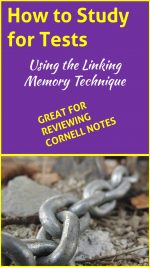How to Memorize Using the Linking Technique
The The Linking Technique can be a helpful tool to help you memorize many seemingly unrelated items or ideas. Linking one idea to another is a powerful memory aid. We all experience sensory stimuli that remind us of something else. You may link drinking a cup of coffee with relaxation, because you frequently practice this association. Hearing Christmas songs just might link you to the feel of your credit card!
The Linking Technique connects the items or ideas we want to remember to one visual theme. Recent hemispheric brain research has proved the power of associations. Our brains act as computer file folders, slotting newly learned information in the same file as already-learned information that fits within that same file. This Linking Technique connects the new information you want to remember with existing information that you already know, much like our brain file folders do. If we take the time to organize new information in same way as our brains, we can improve our retention of that information.
Directions
Select two concrete objects that have a clear relationship to form a memorable pair. Think of this pair like the left and right sides of one link in a chain. Next, link the right side of the first link to the left side of another link to create a second connection in the chain. Continue in this manner to create a memorable chain of paired objects. The links can be endless; however each connection must be well-established and very visual. Substitute concrete objects for any key words that are too abstract to remember well. For example, substituting the concrete “peace sign” for the abstract “peace” would be a much more memorable object with which to pair.
Example
If memorizing a tree, bucket, grass, policeman, horse, cow, a candy bar and a golden ring, you might link them as follows:
Picture a tall oak tree with a golden ring hanging from one of its branches. The ring drops in a red bucket at the base of the tree on the bright green grass. A cow is busy nibbling the grass next to the bucket, while swishing its tail. At the end of the tail a candy bar is attached. A policeman on a white horse is frantically trying to grab the candy bar.
A bit of rehearsal will place these objects into your long-term memory. Memorizing using the The Linking Technique will enable you to retain the memory of many seemingly unrelated items. Linking is a great tool for revising notes into memorable associations. Useful for upcoming tests, lectures, speeches, poetry, stories, shopping lists? Fun and very practical.
Check out these other brief articles on helpful memorization techniques: catch sentences, catch words, association, This Old Man, location, and grouping.
The author’s Essential Study Skills is the study skill curriculum that teaches what students need to know to succeed and thrive in school. Often, the reason why students fail to achieve their academic potential is not
because of laziness or lack of effort, but because they have never learned the basic study skills necessary for success.
The 56 lessons in Essential Study Skills will teach your students to “work smarter, not harder.” Students who master these skills will spend less time, and accomplish more during homework and study time. Their test study will be more productive and they will get better grades. Reading comprehension and vocabulary will improve. Their writing will make more sense and essays will be easier to plan and complete. They will memorize better and forget less. Their schoolwork will seem easier and will be much more enjoyable. Lastly, students will feel better about themselves as learners and will be more motivated to succeed. Essential Study Skills is the ideal curriculum for study skill, life skill, Advocacy/Advisory, Opportunity Program classes. The easy-to-follow lesson format of 1. Personal Assessment 2. Study Skill Tips and 3. Reflection is ideal for self-guided learning and practice. Contact the publisher for affordable site licenses.



